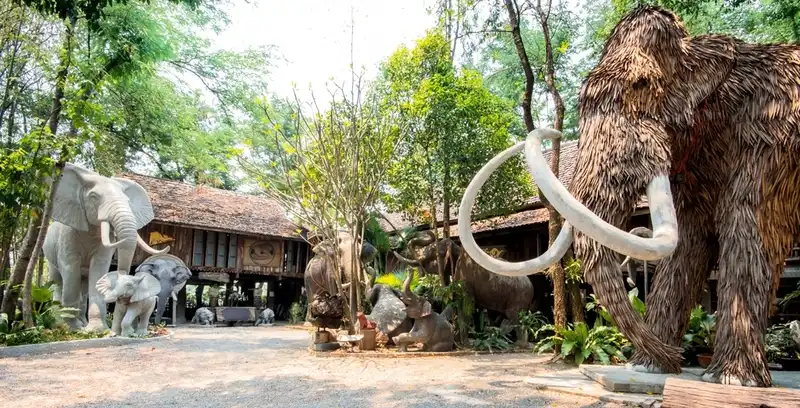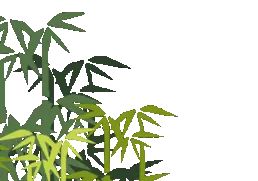Ban Jang Nak Museum

Rating: 4/5 (5 votes)
Chiang Mai attractions
Attractions in Thailand
Open Days: Daily
Opening Hours: 08:00–17:00
Ban Jang Nak Museum in Chiang Mai is one of the most distinctive local museums in Northern Thailand, celebrated for its mastery of traditional Lanna woodcarving. The museum is filled with countless hand-carved wooden elephants, each crafted with exceptional skill by local artisans. Over the years, it has become a cultural landmark where visitors can learn about Lanna craftsmanship, elephant symbolism, and the deep connection between Thai culture and these majestic animals.
The museum was founded in 1985 by master woodcarver “Sala Phet Wiriya,” who was passionate about preserving and passing on the art of Lanna woodcarving. He gathered fellow craftsmen, students, and apprentices from the community, forming a small collective dedicated to keeping traditional techniques alive. What began as a humble workshop gradually grew into a full-fledged museum that now attracts art lovers and travelers from around the world.
In 1988, the well-known columnist Prayoon Janyawong from the Thai Rath newspaper visited the workshop and gave it the name “Ban Jang Nak.” In Northern Thai dialect, “jang” means elephant and “nak” means many—so the name translates to “The House of Many Elephants,” perfectly capturing the museum’s unique identity.
One of the key features that made Ban Jang Nak famous is its innovative approach to elephant woodcarving. Traditionally, elephant carvings had fixed poses, but the artisans here developed more lifelike forms—showing elephants walking in procession, playing in water, grazing, or expressing tender moments between mother and calf. These dynamic carvings became the museum’s signature style and set a new standard for Lanna woodcraft.
The museum also pioneered the use of local materials, such as “ironwood,” to replace teak, which has become increasingly scarce. Ironwood is tougher and more challenging to carve, but when finished, it reveals natural tones and textures that make each sculpture uniquely beautiful. Ban Jang Nak also incorporates traditional techniques like dyeing wood with “black myrobalan” (used in fabric dyeing), resulting in natural, eco-friendly colors that enhance the craft.
Inside the museum, visitors are greeted by an impressive display of wooden elephants in various sizes and emotions. Some are arranged in thematic groups, while others showcase the delicacy of the artisans’ techniques. Many pieces reveal personal stories, experiments with new materials, and award-winning works that mark important milestones in the museum’s journey.
The outdoor area is equally captivating, decorated with carved elephant heads and large-scale sculptures that create a striking backdrop for photographs. Visitors may even encounter artisans working on new pieces, offering a rare glimpse into the process behind traditional Lanna woodcarving.
In 2003, Ban Jang Nak was officially recognized as a private local museum, further boosting its reputation as an important cultural and artistic hub. Travelers, art students, and collectors often visit not only to enjoy the artwork but also to understand the deeper message behind it—raising awareness about the conservation of Thai elephants through the lens of art.
Getting There is simple: From Chiang Mai city, follow the Chiang Mai–San Kamphaeng Road toward Buak Khang Subdistrict, approximately 18–20 km from the city center. The museum is best reached by private car, taxi, or chartered songthaew, and can easily be combined with a cultural route to Bo Sang Handicraft Village, MAIIAM Contemporary Art Museum, San Kamphaeng Hot Springs, or Muang On Cave.
| Name | Ban Jang Nak Museum (Museum of Elephant Wood Carvings) |
| Location | 56/1 Moo 2, Buak Khang Village, Buak Khang Subdistrict, San Kamphaeng District, Chiang Mai 50130 |
| Founded | Established in 1985 by master carver Sala Phet Wiriya; officially recognized as a private museum in 2003 |
| Opening Hours | Daily, 08:00–17:00 |
| Phone Number | 0-5344-6891 |
| Entrance Fee | Free entry; donation box available to support the museum and local artisans |
| Main Exhibition Zones | - Traditional Lanna elephant carvings - Contemporary elephant sculptures - Tool and material displays - Natural wood-dyeing techniques using black myrobalan - Early works and milestone pieces by Sala Phet - Outdoor displays of large-scale elephant heads and sculptures |
| Key Highlights | Early-generation carvings, ironwood sculptures, preserved elephant skeletons, and signature large-scale artworks |
| Getting There | About 18–20 km from Chiang Mai city via San Kamphaeng Road; accessible by car, taxi, or chartered transport |
| Nearby Attractions | - Bo Sang Handicraft Centre (8–10 km) - MAIIAM Contemporary Art Museum (6–8 km) - San Kamphaeng Hot Springs (20–25 km) - Muang On Cave (22–25 km) - San Kamphaeng Walking Street (10–12 km) |
| Nearby Restaurants | - Huen Jai Yong (4–5 km) - Elephants Coffee House (1–2 km) - Kradas Cafe (5–7 km) - Local Northern Thai restaurants in San Kamphaeng (8–10 km) - Cafés along the route to San Kamphaeng Hot Springs |
| Nearby Accommodations | - Thantara Resort Chiang Mai (2 km) - Huanmaisakngam Resort (2.5–3 km) - The Oriental Siam Resort (8–10 km) - Local homestays and small resorts in Buak Khang (3–10 km) - Resorts along the San Kamphaeng Hot Springs route |
| Facilities | Parking area, indoor and outdoor exhibition paths, photo spots, workshop displays, and a peaceful Lanna village atmosphere |
Frequently Asked Questions (FAQ)
Q: Who is Ban Jang Nak Museum suitable for?
A: It is ideal for travelers who love woodcarving, Lanna art, Thai elephant culture, handicrafts, and immersive cultural experiences.
Q: How long should I spend at the museum?
A: A typical visit takes 45–60 minutes, but art enthusiasts may enjoy staying 1–1.5 hours to appreciate the details.
Q: Can I take photos inside?
A: Yes, photography is allowed in most areas. However, visitors should avoid touching the artworks to preserve their condition.
Q: Is there an entrance fee?
A: No official ticket fee is required. Visitors may leave donations to support the museum and artisans.
Q: Can I combine the visit with other attractions?
A: Absolutely. The museum pairs well with Bo Sang Handicraft Village, MAIIAM Museum, San Kamphaeng Hot Springs, and Muang On Cave for a full-day cultural trip.
Comment
| Keyword (Advance) |
 Facebook Fanpage
Facebook Fanpage







 Category:
Category:  Group:
Group:  Historical Sites and Monuments(
Historical Sites and Monuments( Landmarks and Memorials(
Landmarks and Memorials( Royal Palace(
Royal Palace( Art, Craft Centres, Tradition(
Art, Craft Centres, Tradition( Educational Places
Educational Places Museum for Study(
Museum for Study( Educational Gardens, Farm(
Educational Gardens, Farm( Training Center(
Training Center( University
University Places of Worship
Places of Worship Temple(
Temple( Mosque(
Mosque( Other religious and spiritural sites(
Other religious and spiritural sites( Research and Development
Research and Development Royal Project(
Royal Project( Suburban Living
Suburban Living Village, Community(
Village, Community( Local Market(
Local Market( Nature and Wildlife
Nature and Wildlife National Parks and Marine Reserves(
National Parks and Marine Reserves( Mountain (Doi)(
Mountain (Doi)( Dam, Reservoir, Lake(
Dam, Reservoir, Lake( Waterfalls(
Waterfalls( Hot Springs(
Hot Springs( Caves(
Caves( River, Canal(
River, Canal( Other natural attractions(
Other natural attractions( Entertainment and Agricultural
Entertainment and Agricultural Zoos and Aquariums(
Zoos and Aquariums( Animal camps and shows(
Animal camps and shows( Stadium(
Stadium( Farm, Parks, Gardens and Ecotourism(
Farm, Parks, Gardens and Ecotourism( Waterpark(
Waterpark( Theater(
Theater( Outdoor and Adventure Activities(
Outdoor and Adventure Activities( Shopping
Shopping Shopping and Night Market(
Shopping and Night Market( Restaurant
Restaurant Michelin Star(
Michelin Star( Michelin Guide(
Michelin Guide( Call Customer Service in Tourism
Call Customer Service in Tourism Call Customer Service in Tourism(
Call Customer Service in Tourism( Travel Articles, Recipes
Travel Articles, Recipes Travel Review, Food Review(
Travel Review, Food Review( Food Menu, North Recipes(
Food Menu, North Recipes( Thai Desserts, North Recipes(
Thai Desserts, North Recipes(